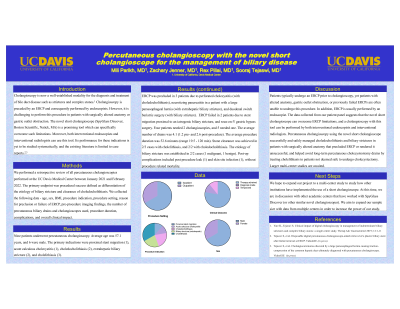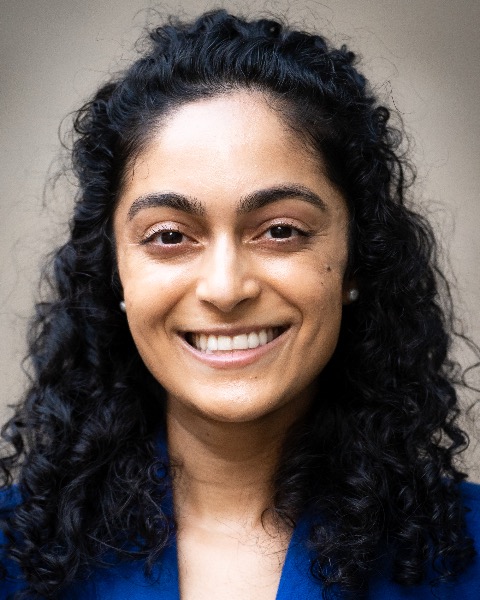Back


Poster Session C - Monday Afternoon
Category: Biliary/Pancreas
C0020 - Percutaneous Cholangioscopy With the Novel Short Cholangioscope for the Management of Biliary Disease
Monday, October 24, 2022
3:00 PM – 5:00 PM ET
Location: Crown Ballroom

Has Audio

Mili Parikh, MD
UC Davis Medical Center
Sacramento, CA
Presenting Author(s)
Mili Parikh, MD1, Zachary Jenner, MD1, Rex Pillai, MD1, Christopher Laing, MD2, Carol Parise, PhD2, Sooraj Tejaswi, MD1
1UC Davis Medical Center, Sacramento, CA; 2Sutter Health Medical Center, Sacramento, CA
Introduction: Cholangioscopy is indicated for the diagnosis and treatment of biliary strictures and complex choledocholithiasis but is often precluded in patients with altered anatomy. Percutaneous cholangioscopy with the novel short cholangioscope (SpyGlass Discover, Boston Scientific, Natick, MA) can circumvent this limitation. Its performance has not been systematically evaluated.
Methods: We performed a retrospective review of percutaneous cholangioscopies performed between January 2021 and February 2022 at UCDMC and Sutter Health Medical Center. The primary endpoint was procedural success defined as differentiation of the etiology of biliary stricture, and clearance of choledocholithiasis. We collected the following data - age, sex, BMI, procedure indication, reason for preclusion or failure of ERCP, the number of percutaneous biliary drains and cholangioscopes used, procedure duration, complications, and overall clinical impact.
Results: Thirteen patients were studied. Average age: 59.7 years. Eight were male.
Primary indications: proximal stent migration (1), acute calculous cholecystitis (1), choledocholithiasis (5), extrahepatic biliary stricture (2), observed jaundice (1), cholelithiasis (3).
ERCP was precluded in 3 patients due to perforated cholecystitis (with choledocholithiasis), necrotizing pancreatitis with a large paraesophageal hernia (with extrahepatic biliary stricture), and duodenal switch bariatric surgery (with biliary stricture).
ERCP failed in 4 patients due to stent migration proximal to an iatrogenic biliary stricture, and roux-en-Y gastric bypass surgery.
One patient needed 3 cholangioscopies, 4 patients needed two, and 8 needed one.
Average number of drains: 4.2 (1 pre- and 3 post-procedure).
Average procedure duration: 52.6 minutes (range 19.5 - 120 min).
Stone clearance achieved: 2/3 cases with cholelithiasis, 4/5 with choledocholithiasis.
Etiology of biliary stricture established: 2/2 cases (1 malignant, 1 benign).
Post-op complications: post procedure leak (2), recurrent cholangitis (1), and skin site infection (1), without procedure related mortality.
Discussion: Percutaneous cholangioscopy using the novel short cholangioscope successfully and safely managed choledocholithiasis and biliary strictures in patients with surgically altered anatomy that precluded ERCP or rendered it unsuccessful, and helped avoid long-term percutaneous cholecystostomy drains by treating cholelithiasis in patients unable to undergo cholecystectomy. Larger multi-center studies are awaited.
Disclosures:
Mili Parikh, MD1, Zachary Jenner, MD1, Rex Pillai, MD1, Christopher Laing, MD2, Carol Parise, PhD2, Sooraj Tejaswi, MD1. C0020 - Percutaneous Cholangioscopy With the Novel Short Cholangioscope for the Management of Biliary Disease, ACG 2022 Annual Scientific Meeting Abstracts. Charlotte, NC: American College of Gastroenterology.
1UC Davis Medical Center, Sacramento, CA; 2Sutter Health Medical Center, Sacramento, CA
Introduction: Cholangioscopy is indicated for the diagnosis and treatment of biliary strictures and complex choledocholithiasis but is often precluded in patients with altered anatomy. Percutaneous cholangioscopy with the novel short cholangioscope (SpyGlass Discover, Boston Scientific, Natick, MA) can circumvent this limitation. Its performance has not been systematically evaluated.
Methods: We performed a retrospective review of percutaneous cholangioscopies performed between January 2021 and February 2022 at UCDMC and Sutter Health Medical Center. The primary endpoint was procedural success defined as differentiation of the etiology of biliary stricture, and clearance of choledocholithiasis. We collected the following data - age, sex, BMI, procedure indication, reason for preclusion or failure of ERCP, the number of percutaneous biliary drains and cholangioscopes used, procedure duration, complications, and overall clinical impact.
Results: Thirteen patients were studied. Average age: 59.7 years. Eight were male.
Primary indications: proximal stent migration (1), acute calculous cholecystitis (1), choledocholithiasis (5), extrahepatic biliary stricture (2), observed jaundice (1), cholelithiasis (3).
ERCP was precluded in 3 patients due to perforated cholecystitis (with choledocholithiasis), necrotizing pancreatitis with a large paraesophageal hernia (with extrahepatic biliary stricture), and duodenal switch bariatric surgery (with biliary stricture).
ERCP failed in 4 patients due to stent migration proximal to an iatrogenic biliary stricture, and roux-en-Y gastric bypass surgery.
One patient needed 3 cholangioscopies, 4 patients needed two, and 8 needed one.
Average number of drains: 4.2 (1 pre- and 3 post-procedure).
Average procedure duration: 52.6 minutes (range 19.5 - 120 min).
Stone clearance achieved: 2/3 cases with cholelithiasis, 4/5 with choledocholithiasis.
Etiology of biliary stricture established: 2/2 cases (1 malignant, 1 benign).
Post-op complications: post procedure leak (2), recurrent cholangitis (1), and skin site infection (1), without procedure related mortality.
Discussion: Percutaneous cholangioscopy using the novel short cholangioscope successfully and safely managed choledocholithiasis and biliary strictures in patients with surgically altered anatomy that precluded ERCP or rendered it unsuccessful, and helped avoid long-term percutaneous cholecystostomy drains by treating cholelithiasis in patients unable to undergo cholecystectomy. Larger multi-center studies are awaited.
Disclosures:
Mili Parikh indicated no relevant financial relationships.
Zachary Jenner indicated no relevant financial relationships.
Rex Pillai indicated no relevant financial relationships.
Christopher Laing indicated no relevant financial relationships.
Carol Parise indicated no relevant financial relationships.
Sooraj Tejaswi indicated no relevant financial relationships.
Mili Parikh, MD1, Zachary Jenner, MD1, Rex Pillai, MD1, Christopher Laing, MD2, Carol Parise, PhD2, Sooraj Tejaswi, MD1. C0020 - Percutaneous Cholangioscopy With the Novel Short Cholangioscope for the Management of Biliary Disease, ACG 2022 Annual Scientific Meeting Abstracts. Charlotte, NC: American College of Gastroenterology.
